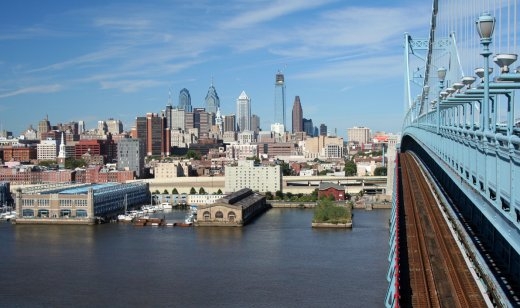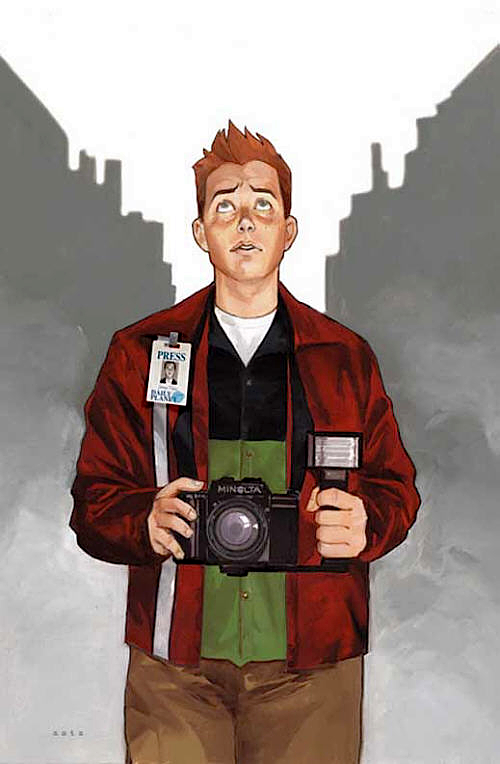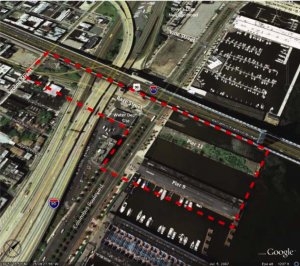
[Photo courtesy of PHILLYSKYLINE]
 BY NICK POWELL METRO CORRESPONDENT Cantankerous pundits and enthusiastic pols shared the stage last night at the Festival Pier where the Delaware River Waterfront Corporation hosted a public presentation showcasing the design finalists for the Pier 11 project, an endeavor that, depending whom you ask, will either re-introduce Philadelphians to the beauty of the waterfront, or will drift away into limbo just like other ambitious developments such as the re-design of Penn’s Landing that never happened. Pier 11, an eighty by five hundred forty foot structure that jets out onto the river next to the Ben Franklin Bridge, has sat untouched for decades, but with the help of several grants and the strong will of the DRWC, it is moving closer to being developed into a key component of the waterfront renaissance.
BY NICK POWELL METRO CORRESPONDENT Cantankerous pundits and enthusiastic pols shared the stage last night at the Festival Pier where the Delaware River Waterfront Corporation hosted a public presentation showcasing the design finalists for the Pier 11 project, an endeavor that, depending whom you ask, will either re-introduce Philadelphians to the beauty of the waterfront, or will drift away into limbo just like other ambitious developments such as the re-design of Penn’s Landing that never happened. Pier 11, an eighty by five hundred forty foot structure that jets out onto the river next to the Ben Franklin Bridge, has sat untouched for decades, but with the help of several grants and the strong will of the DRWC, it is moving closer to being developed into a key component of the waterfront renaissance.
Among the Philadelphia politicians who graced the event with their presence were Mayor Michael Nutter, and Councilmen Frank DiCicco and Frank Rizzo, in a demonstration of the city’s solidarity in getting this venture under way. Mayor Nutter and Councilman DiCicco both made remarks to begin the event, although they were mostly limited to the obligatory “thank-yous” and generic statements such as, “What I’m most excited about is that they’re excited to design in Philadelphia,” which is how Mayor Nutter to closed his speech. The four finalists for the design project were drawn from an original list of sixteen firms to begin with, and each expressed contrasting methods as to best enhance Pier 11. They were each allotted twenty minutes for their presentation followed by a ten-minute period for questions from the audience.
Andropogon kicked off the presentation with their “Eco-Pier Park,” which in their words “illustrates Philadelphia’s commitment to becoming the greenest city in America,” and “melds vision with practicality.” Their presentation included plans for renewable energy opportunities such as wind turbines, water pumps and a large “iconic” canopy stretching underneath I-95 all the way to 2nd Street, and would harness the strong wind currents of the waterfront. Also included in the Andropogon plan is a makeover for the adjacent Pier 9, which would be made into a Museum of Environmental Art Annex, designed to connect Philadelphians to the unique ecology of the river. Andropogon also noted the site’s potential as a training ground for green jobs, a notion that surely caught Mayor Nutter’s attention.
The presentations that followed, from James Corner Field Operations and Michael Van Valkenburgh Associates,  curiously did not show a specific plan for the pier, but rather focused on similar projects that their respective companies had successfully completed in cities such as New York. Their presentations focused on the unique scale of Pier 11, and showcased these aforementioned projects as means to highlight their aesthetic qualities. Mr. Corner, a Philadelphia resident of 25 years by way of Manchester, England, spoke of going up in a friend’s Cessna jet, and being “blown away by the beauty of the river.” Contrary to Andropogon’s green agenda, Mr. Corner said that, “Pier 11 ought to be a social space,” a space that would bring Philadelphia residents together in their desire to experience the waterfront. His presentation included images of the recently completed Highline in New York City, where his company transformed a decrepit, elevated set of former railroad tracks into a scenic park. The project, Mr. Corner noted, was a $100 million dollar investment that reaped over $1 billion in profit for New York City thanks to adjacent real estate and commerce, numbers that surely had the audience wistfully dreaming of a vibrant and thriving waterfront as an economic boon for Philadelphia. However, while Mr. Corner dazzled with his images of proposed re-development in New York City and Toronto, his lack of specifics left something to be desired.
curiously did not show a specific plan for the pier, but rather focused on similar projects that their respective companies had successfully completed in cities such as New York. Their presentations focused on the unique scale of Pier 11, and showcased these aforementioned projects as means to highlight their aesthetic qualities. Mr. Corner, a Philadelphia resident of 25 years by way of Manchester, England, spoke of going up in a friend’s Cessna jet, and being “blown away by the beauty of the river.” Contrary to Andropogon’s green agenda, Mr. Corner said that, “Pier 11 ought to be a social space,” a space that would bring Philadelphia residents together in their desire to experience the waterfront. His presentation included images of the recently completed Highline in New York City, where his company transformed a decrepit, elevated set of former railroad tracks into a scenic park. The project, Mr. Corner noted, was a $100 million dollar investment that reaped over $1 billion in profit for New York City thanks to adjacent real estate and commerce, numbers that surely had the audience wistfully dreaming of a vibrant and thriving waterfront as an economic boon for Philadelphia. However, while Mr. Corner dazzled with his images of proposed re-development in New York City and Toronto, his lack of specifics left something to be desired.
By the time Michael Van Valkenburgh took the stage, some of the audience had grown restless, and Mr. Van Valkenburgh had to answer for the sins of those that came before him. One man, a resident of Old City, spoke of how when he purchased his apartment in 1990, the real estate agent spoke of the waterfront as Philadelphia’s next great achievement, only that he is still waiting for such an undertaking. He adamantly expressed his lack of faith in the city to get anything done, to which Mr. Van Valkenburgh replied, “When the mayor of your city shows up to a meeting like this and says the things he said, I think you have to put a lot of stock into that.”
W Architecture and Landscape Architecture concluded the evening with maybe the most unique proposal yet, suggesting several ways to best maximize the relatively small size of the pier, including fragmenting the pier with bridges, allowing for an intimate connection with the river. W also illustrated their past work in New York City, and emphasized a collaboration with artists and acknowledging the history of the pier, in their design for Pier 11. The audience was very much split in their reactions to the proposals, with some hailing the companies’ innovation, and others slamming their plans as over-ambitious. Jim Colins , a 63-year old attorney and resident of Pier 5, enjoyed W’s proposal the best, especially their acknowledgment of the pier’s history, but had some choice words for Andropogon’s Eco-Pier. “It felt too contrived, it’s too much all at once. They weren’t recognizing the history of the pier. They talk about the fact that the windmills will allow us to see the winds, well I can see the winds just fine by looking at the current.”
Others such as Harris Steinberg felt that the design groups did the waterfront great justice. Mr. Steinberg is the director of Penn Praxis, which not long ago drafted a report of the best uses for the waterfront, and he felt that the groups very much kept with Penn Praxis’ vision. “They literally followed our recommendations to a tee,” Mr. Steinberg said. “I really think you can’t go wrong with four extremely talented groups. It’s a very exciting field to draw from, I wouldn’t want to bet on one versus the other.” Jethro Heiko, 36, the founder of Casino-Free Philadelphia, provided one of the night’s more animated moments when he interrupted the presentation and attacked the city’s commitment to casinos near the waterfront, specifically the use of the waterfront for surface parking for the casinos. Mr.Heiko elaborated on his concerns for the waterfront at the conclusion of the evening. “The new lease for the casino includes 31 acres of surface parking,” said Mr. Heiko, “I love 1 acre, and [the design groups] are great. But if we want to be serious, we have to think big, and the mayor and city council are thinking small.”
The designs are in, the people have spoken, now let’s see if the city holds up its end of the bargain.
